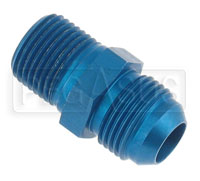Identification and Use
| Ordering and using NPT fittings can be confusing because the nominal sizes have no relation to thread size. To make matters worse, NPT fittings do not fit together the way most other fittings do. This has led many people to believe that they have mismatched sizes. Fortunately, NPT sizes are easy to identify. The sizes are also different enough that it is impossible to even start to assemble two different sizes together. |
Background
NPT stands for National Pipe Tapered thread. It is also sometimes called National Pipe Thread, NPTF (F for Fuel), American Standard Taper, or simply "pipe". Most other plumbing fittings have straight or parallel threads, but NPT fittings have a tapered thread profile. The outside diameter of the male thread tapers down from the base, so the end of the fitting has a smaller OD than the base of the fitting. The matching female thread has a larger OD at the opening, tapering down as it goes in.
NPT fitting sizes refer to the nominal ID of a standard cast-iron pipe. This is where the confusion comes in. Most plumbing fittings are named for the thread size, but NPT sizes are not. An NPT fitting measuring 3/8" OD thread is actually a 1/8 NPT, not 3/8 NPT. Use the chart below to positively identify NPT fitting sizes.
| NPT Size Identification | |||
|---|---|---|---|
| Male Thread OD at middle of taper |
Threads per Inch | Female Thread ID at opening |
NPT Size |
| 0.40" | 27 | 0.36" | 1/8 NPT |
| 0.53" | 18 | 0.47" | 1/4 NPT |
| 0.67" | 18 | 0.59" | 3/8 NPT |
| 0.83" | 14 | 0.75" | 1/2 NPT |
| 1.04" | 14 | 0.95" | 3/4 NPT |
| 1.30" | 11 1/2 | 1.20" | 1" NPT |
Proper Practice
The tapered thread seals by means of an interference fit between the male and female threads. This means that NPT fittings should never bottom out in the port. The fitting should screw in only partway before jamming. If an NPT fitting screws all the way into a female port without binding, the threads are either mis-tapped or worn out, or the female part may have cracked. After final tightening using the "Turns Past Finger Tight" method, 3 to 6 full threads should be engaged.
To avoid undersized threads that bottom out without sealing, manufacturers often make the male threads slightly oversized and female threads a little tight. This can lead to a fitting which does not screw in far enough for a secure connection. (See the table below for recommended thread engagement.) Too-tight fits are easily remedied by repeatedly hand-tightening the fitting into the port, turning just a little farther each time. This burnishes the threads and allows more thread engagement. Be careful not to overtighten or force the fitting, as this can crack the female part. The idea is to polish or burnish the threads, not to change the thread size.
Once you are satisfied with the thread engagement, you need to disassemble the fittings one last time. Clean any grit off the threads and apply a thread sealant. Because NPT fittings seal at the threads instead of at a flare or at the hex, thread sealant is the only type of gasket you can use. We at Pegasus recommend a liquid or paste sealant such as Loctite 565 PST Thread Sealant (Part No. LT-37396) instead of plumber's tape. Plumber's tape can be trickier to use, and fragments can break loose and cause problems in sensitive systems.
| NPT Fitting Assembly | ||
|---|---|---|
| NPT Size | Turns Past Finger-Tight* |
Thread Engagement Length (Approximate)** |
| 1/8 NPT | 1.5 to 3 | 1/4" |
| 1/4 NPT | 1.5 to 3 | 3/8" |
| 3/8 NPT | 1.5 to 3 | 3/8" |
| 1/2 NPT | 1.5 to 3 | 1/2" |
| 3/4 NPT | 1.5 to 3 | 9/16" |
| 1" NPT | 1 to 2.5 | 11/16" |
* Softer materials require fewer turns past finger-tight. The wide range allows for "clocking" fittings in the desired direction when necessary.
** Actual thread engagement length varies depending on material finish and manufacturing tolerances.
One Final Note
You will notice that no torque values are given in the above table. Never use a torque wrench to tighten NPT fittings! There are far too many variables in play to be able to recommend a torque value for any given size.
Assembling straight-thread fittings (and other threaded fasteners) requires a preload in the joint, which has a direct correlation to torque on the fitting or fastener. Assembling NPT fittings focuses on creating a leak-free joint, which does not have a correlation to fitting torque.


